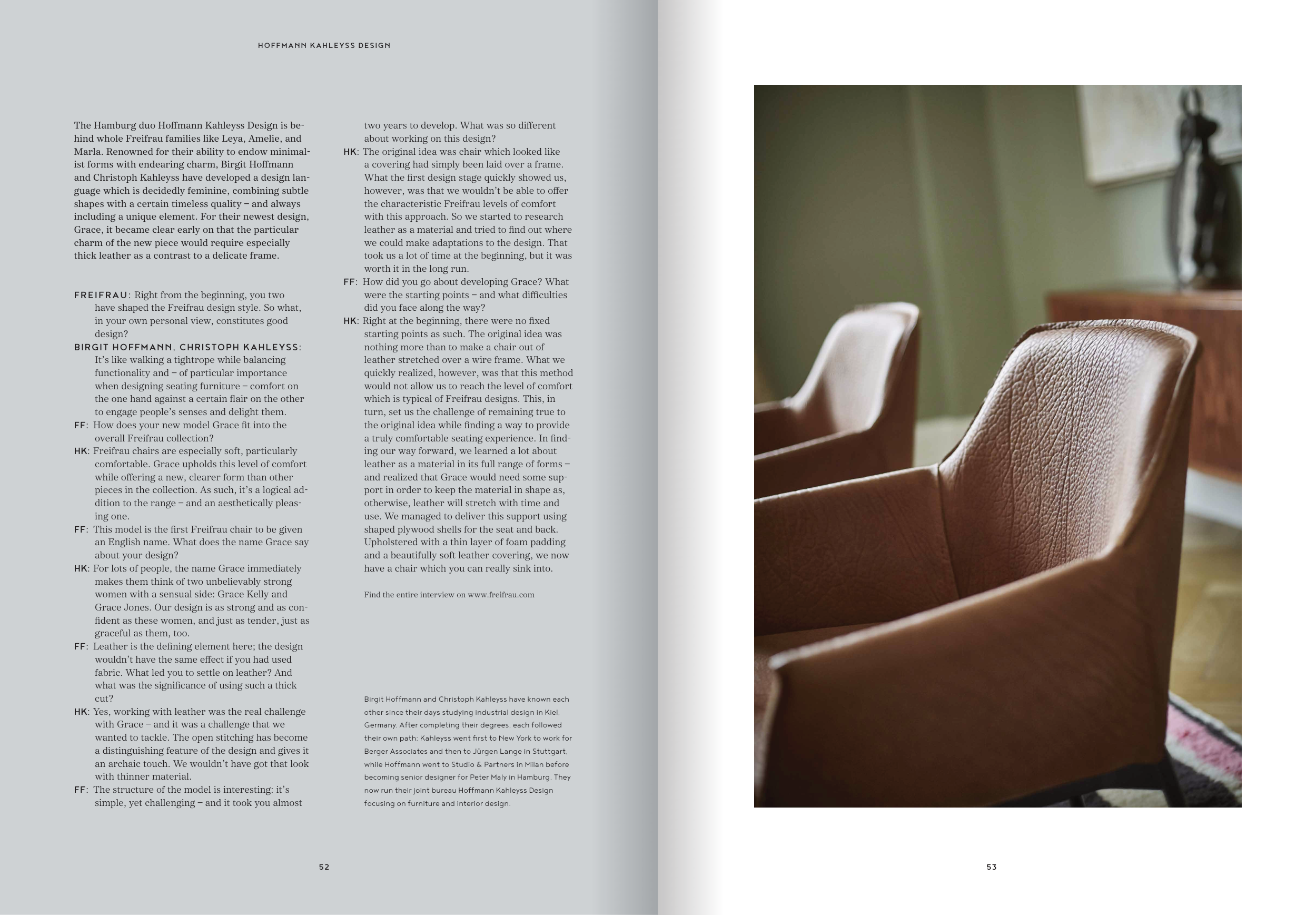53
HOFFMANN KAHLEYSS DESIGN
The Hamburg duo Hoffmann Kahleyss Design is be-
hind whole Freifrau families like Leya, Amelie, and
Marla. Renowned for their ability to endow minimal-
ist forms with endearing charm, Birgit Hoffmann
and Christoph Kahleyss have developed a design lan-
guage which is decidedly feminine, combining subtle
shapes with a certain timeless quality – and always
including a unique element. For their newest design,
Grace, it became clear early on that the particular
charm of the new piece would require especially
thick leather as a contrast to a delicate frame.
FREIFRAU: Right from the beginning, you two
have shaped the Freifrau design style. So what,
in your own personal view, constitutes good
design?
BIRGIT HOFFMANN, CHRISTOPH KAHLEYSS:
It’s like walking a tightrope while balancing
functionality and – of particular importance
when designing seating furniture – comfort on
the one hand against a certain flair on the other
to engage people’s senses and delight them.
FF: How does your new model Grace fit into the
overall Freifrau collection?
HK: Freifrau chairs are especially soft, particularly
comfortable. Grace upholds this level of comfort
while offering a new, clearer form than other
pieces in the collection. As such, it’s a logical ad-
dition to the range – and an aesthetically pleas-
ing one.
FF: This model is the first Freifrau chair to be given
an English name. What does the name Grace say
about your design?
HK: For lots of people, the name Grace immediately
makes them think of two unbelievably strong
women with a sensual side: Grace Kelly and
Grace Jones. Our design is as strong and as con-
fident as these women, and just as tender, just as
graceful as them, too.
FF: Leather is the defining element here; the design
wouldn’t have the same effect if you had used
fabric. What led you to settle on leather? And
what was the significance of using such a thick
cut?
HK: Yes, working with leather was the real challenge
with Grace – and it was a challenge that we
wanted to tackle. The open stitching has become
a distinguishing feature of the design and gives it
an archaic touch. We wouldn’t have got that look
with thinner material.
FF: The structure of the model is interesting: it’s
simple, yet challenging – and it took you almost
two years to develop. What was so different
about working on this design?
HK: The original idea was chair which looked like
a covering had simply been laid over a frame.
What the first design stage quickly showed us,
however, was that we wouldn’t be able to offer
the characteristic Freifrau levels of comfort
with this approach. So we started to research
leather as a material and tried to find out where
we could make adaptations to the design. That
took us a lot of time at the beginning, but it was
worth it in the long run.
FF: How did you go about developing Grace? What
were the starting points – and what difficulties
did you face along the way?
HK: Right at the beginning, there were no fixed
starting points as such. The original idea was
nothing more than to make a chair out of
leather stretched over a wire frame. What we
quickly realized, however, was that this method
would not allow us to reach the level of comfort
which is typical of Freifrau designs. This, in
turn, set us the challenge of remaining true to
the original idea while finding a way to provide
a truly comfortable seating experience. In find-
ing our way forward, we learned a lot about
leather as a material in its full range of forms –
and realized that Grace would need some sup-
port in order to keep the material in shape as,
otherwise, leather will stretch with time and
use. We managed to deliver this support using
shaped plywood shells for the seat and back.
Upholstered with a thin layer of foam padding
and a beautifully soft leather covering, we now
have a chair which you can really sink into.
Find the entire interview on www.freifrau.com
Birgit Hoffmann and Christoph Kahleyss have known each
other since their days studying industrial design in Kiel,
Germany. After completing their degrees, each followed
their own path: Kahleyss went first to New York to work for
Berger Associates and then to Jürgen Lange in Stuttgart,
while Hoffmann went to Studio & Partners in Milan before
becoming senior designer for Peter Maly in Hamburg. They
now run their joint bureau Hoffmann Kahleyss Design
focusing on furniture and interior design.
52


